Being a Scotland fan is difficult.
The long arm of history tells you not to get too excited and that no matter what the situation is or what players you have at your disposal, they will still struggle to get out of the group stages.
Even going into this tournament where, in qualification, Scotland were one of the form teams in the whole competition, there is still a sense of resignation amongst fans of Scotland.
Indeed, that sense of fatalism is normal for a Scottish football fan and recent matches against the Netherlands, and Northern Ireland have only served to enhance that, as Scotland conceded five goals across the two matches and scored none.
In these matches, Scotland appear to have regressed from the all-action side that had impressed so much earlier in qualification.
Overall, however, Steve Clarke’s performance has been overwhelmingly positive.
For the first time since the 1998 World Cup, they have qualified for a major tournament without having to rely on a playoff.
Indeed, during qualification, Scotland enjoyed victory over Spain and Norway on the way to qualifying.
Scotland came into the tournament with some injury issues, with the Bologna midfielder Lewis Ferguson set to miss the tournament and the likes of Aaron Hickey and Stuart Armstrong struggling to prove their fitness before the start of the tournament.
If there is one factor that will affect the Scottish side more than any other, it could be the lack of depth in key positions.
They are in a position at the moment where they have key players who are playing at a high level with teams in the Premier League, but behind those players, they are still relying on domestic options.
Could this be the competition when Scotland finally progress through the group stages and into the knockout rounds?
Our tactical analysis and team-focused scout report aims to provide some in-depth analysis of Scotland’s tactics and what viewers can expect from them in this summer’s tournament.
Starting XI
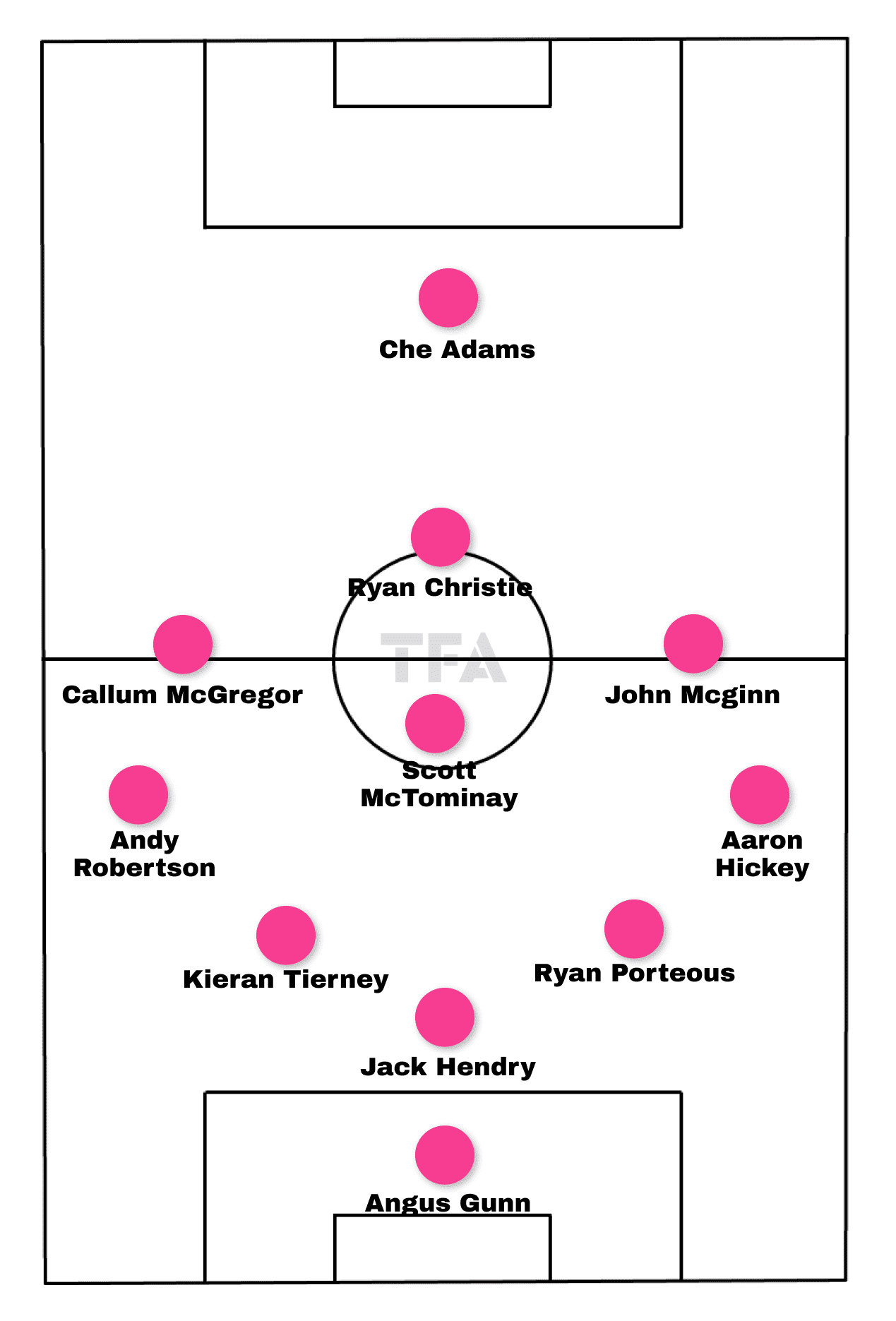
We believe that Scotland will line-up this summer in a 5-4-1 system with three narrow central midfielders and one more advanced midfielder sitting just ahead and behind the lone striker.
One of the biggest issues that Scotland have had in recent seasons has been that two of their best players are primarily left-backs in Andy Robertson of Liverpool and Kieran Tierney of Real Sociedad (on loan from Arsenal).
To get around this, we have seen Clarke choose to use Tierney as the left-sided central defender in a back-three system, with Jack Hendry and Ryan Porteous likely to fill the other two positions.
There are injury concerns at right back, with Aaron Hickey of Brentford struggling to regain fitness.
As such, Clarke has called Ross McCrorie of Bristol City up to his provisional squad.
Billy Gilmour is unlikely to find a space in the starting lineup.
Scott McTominay, Scotland’s top scorer in qualification, Callum McGregor and John McGinn will play as the narrow midfielders, with Ryan Christie bringing creativity ahead of them.
For the striker position, we believe that Southampton’s Che Adams will get the nod ahead of Lyndon Dykes.
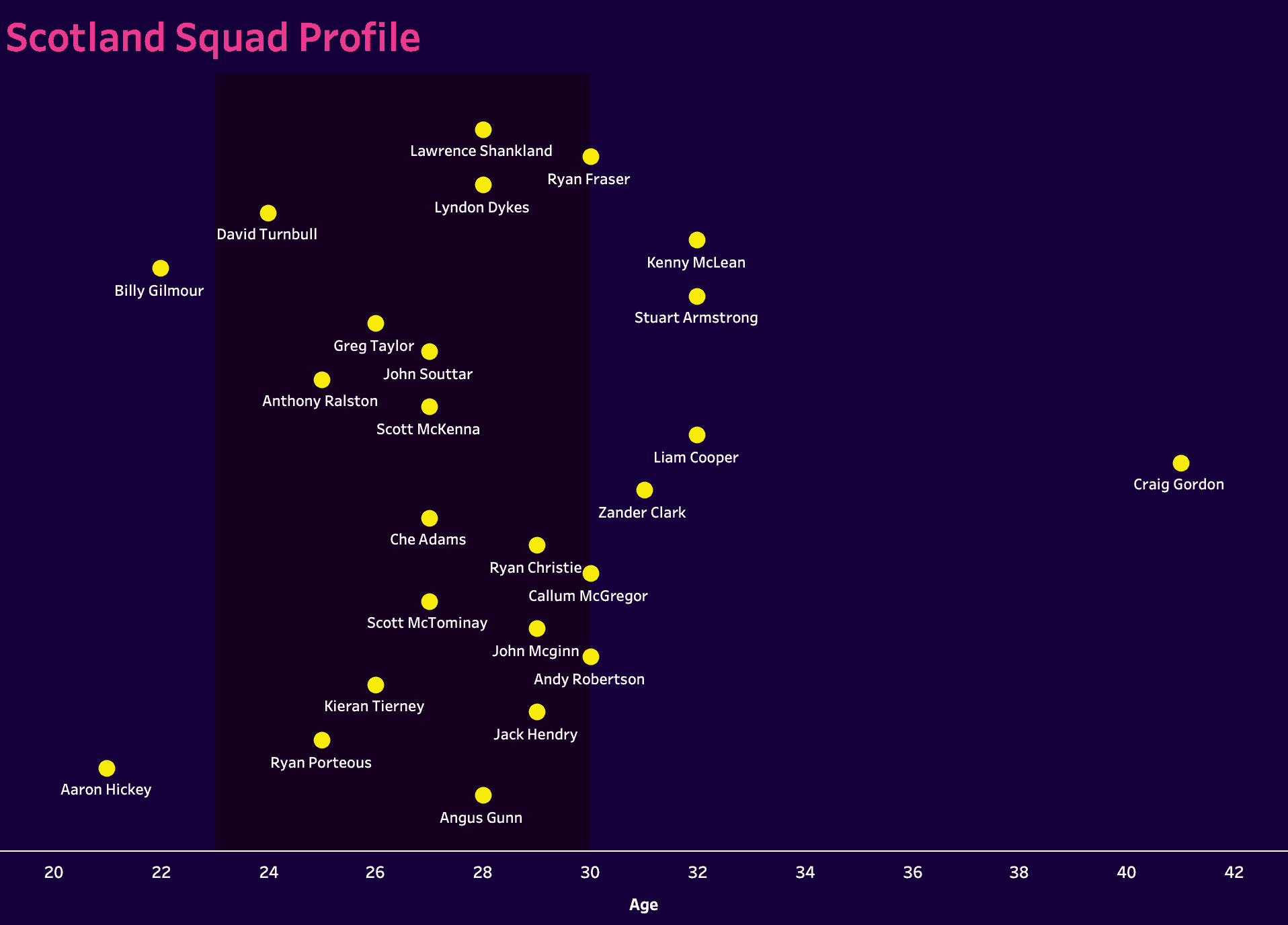
Scotland has an older squad; only Aaron Hickey and Billy Gilmour are under 23 years old on our graphic.
However, Steve Clarke did spring a late surprise with pre-selection by including the 18-year-old Liverpool player Ben Doak, who has yet to make his senior debut at international level.
Attacking phase
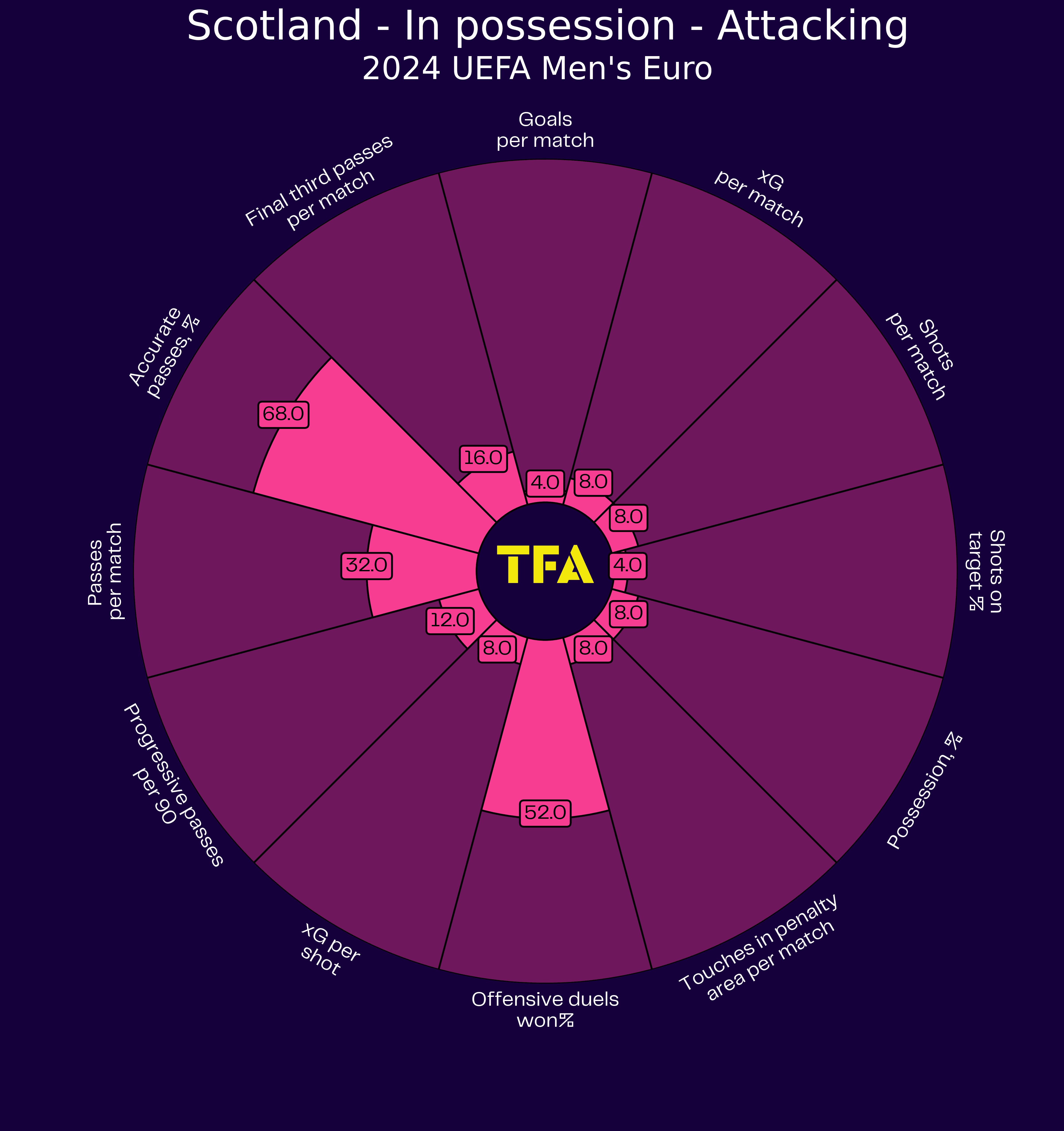
We have to be honest in saying that from a data perspective, Scotland’s outputs over the last calendar year have been less than impressive.
As you can see, they impress in terms of their passing and possession retention, but typically, this is only in the first two-thirds of the pitch.
In terms of chance creation, they rely more on set pieces and chances created in moments of transition.
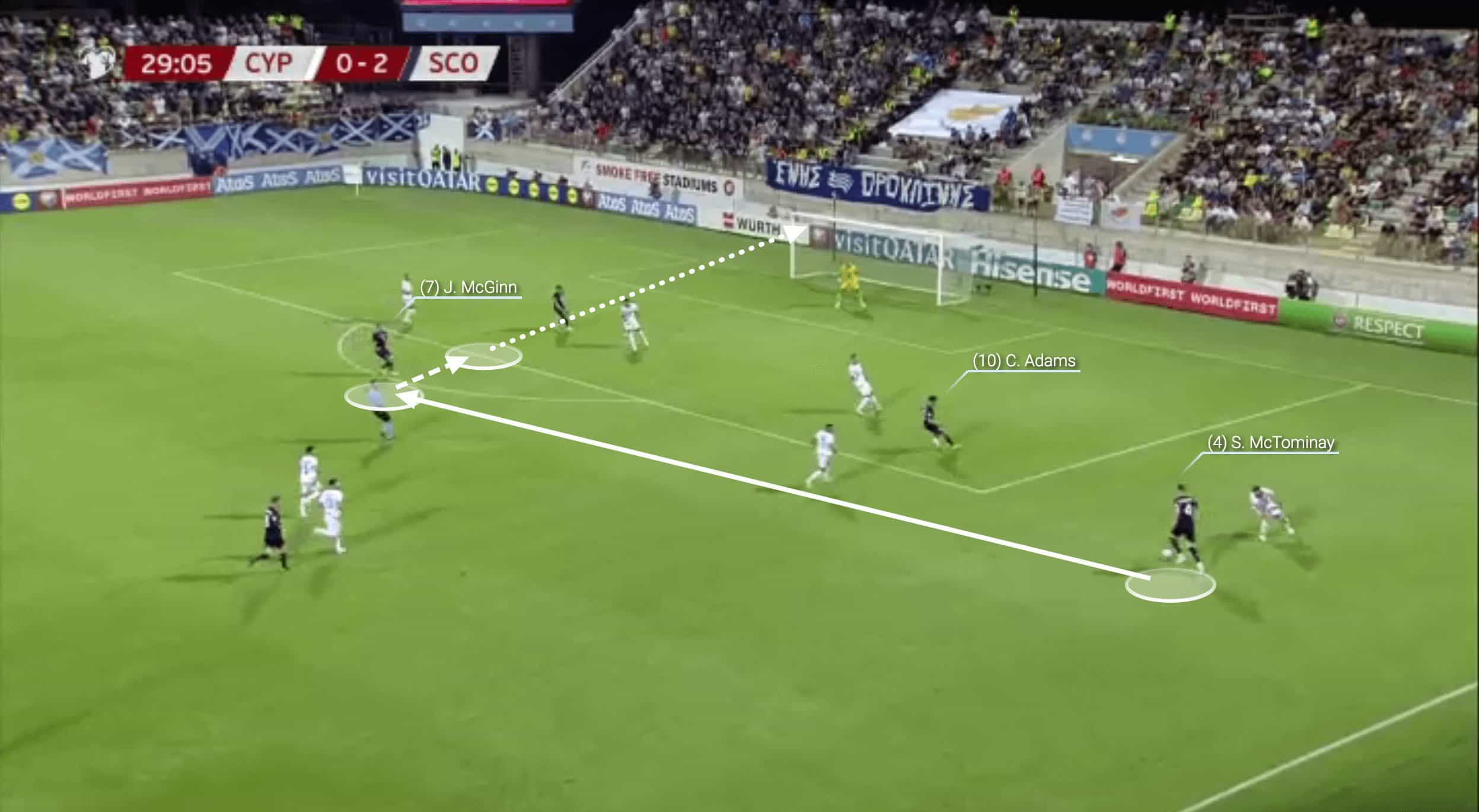
Scotland’s attacking threat tends to come from their midfielders pushing forward and occupying advanced positions in the opposition half.
Their striker, whether Adams or Dykes, play as a platform or focal point for the attack in that they push the opposition defenders back and create spaces for teammates to fill in when they are moving to attack from behind.
This is part of the reason that the top-scorers for Scotland in qualification were midfielders.
We see this in this example as the midfielders for Scotland create and then finish the chance for Scotland vs Cyprus in qualification.
It is Scott McTominay who has pushed high on the right-hand side in transition.
With Che Adams moving narrow and dragging players out of position, the cross finds John McGinn on the edge of the area.
The Villa midfielder controls and fires the ball low into the corner.
The likes of McTominay and McGinn will consistently move into advanced areas to join the attack.
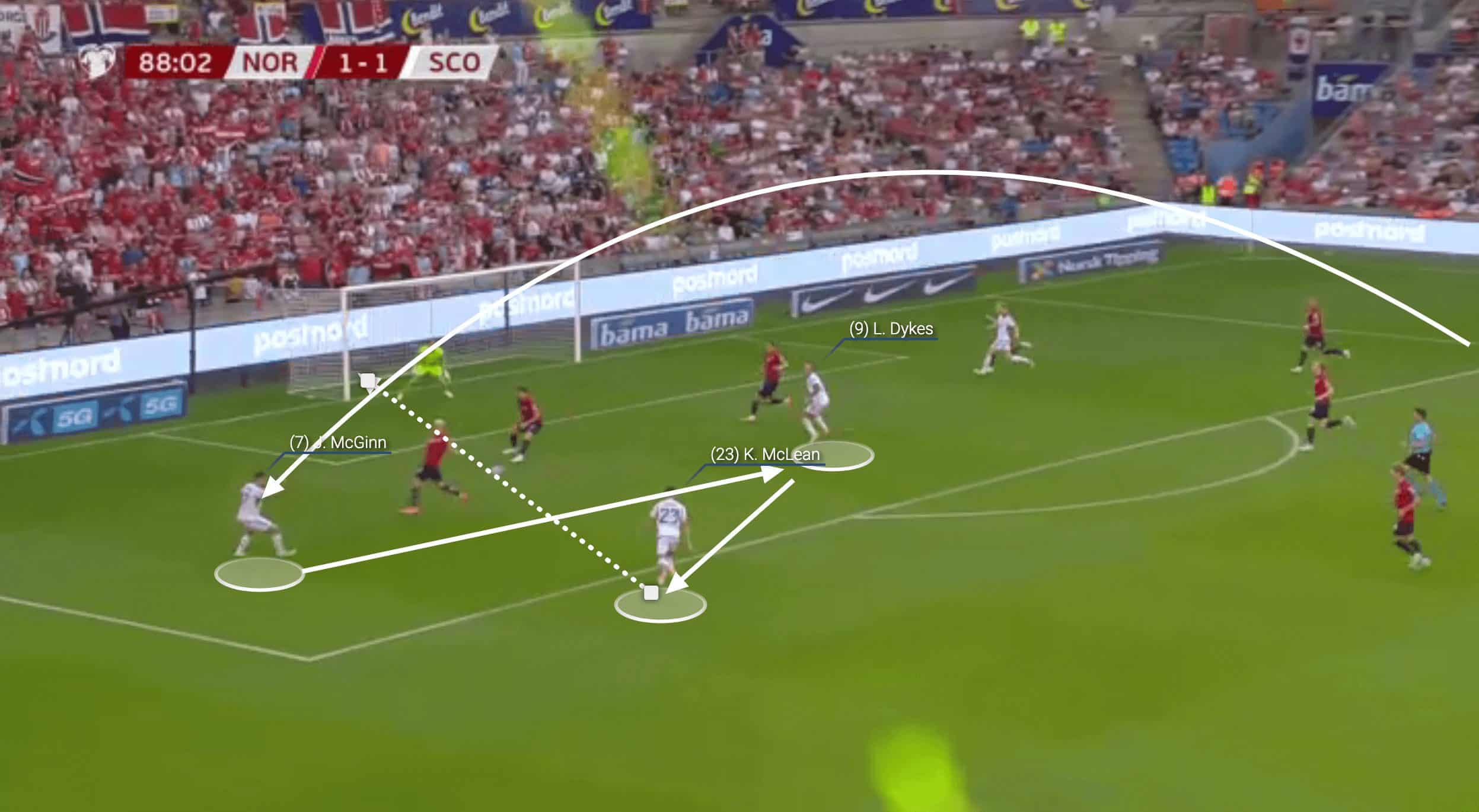
In the match away to Norway, Norwich midfielder Kenny McLean makes the late run to join the attack.
The high cross from the right-hand side is played again by Scott McTominay, who has made a long run to occupy space in the wide areas.
He plays the ball across to find John McGinn on the far side of the penalty area.
As McGinn knocks the ball back across goal to find Lyndon Dykes it is McLean who is making the run from deep to pick up the ball on the edge of the area before finishing low and with power.
Scotland will consistently look to use their midfielders running into advanced areas to unbalance and overload the opposition’s defensive structure.
Do not expect to see Scotland being possession-dominant throughout the tournament though.
Defensive phase
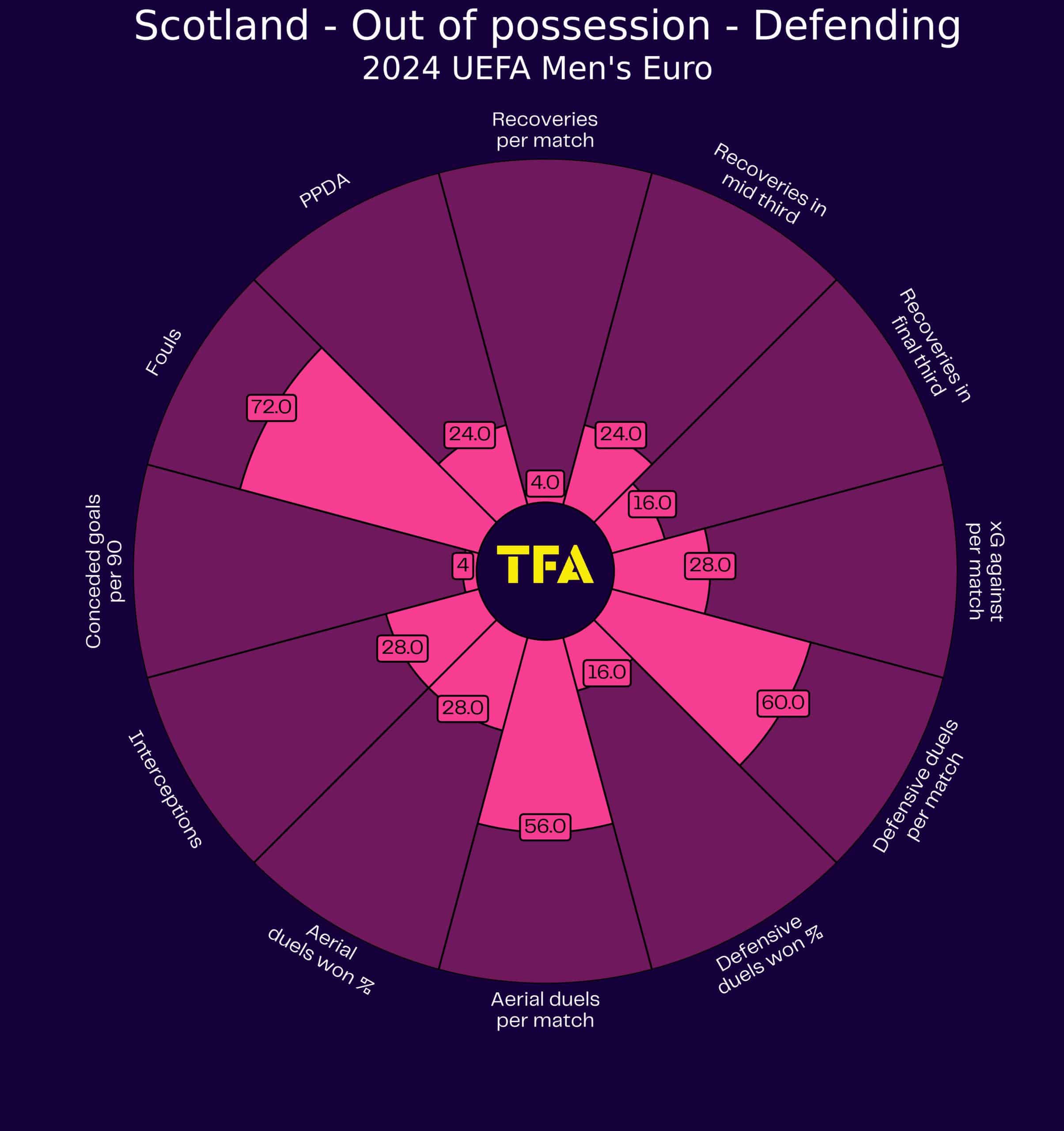
From a defensive perspective, when we examine the data across the last calendar year, we can again see that Scotland does not stand out in any key area.
Defensively, we can expect to see Scotland consistently defend in a deeper block as they look for opportunities to attack in transition.
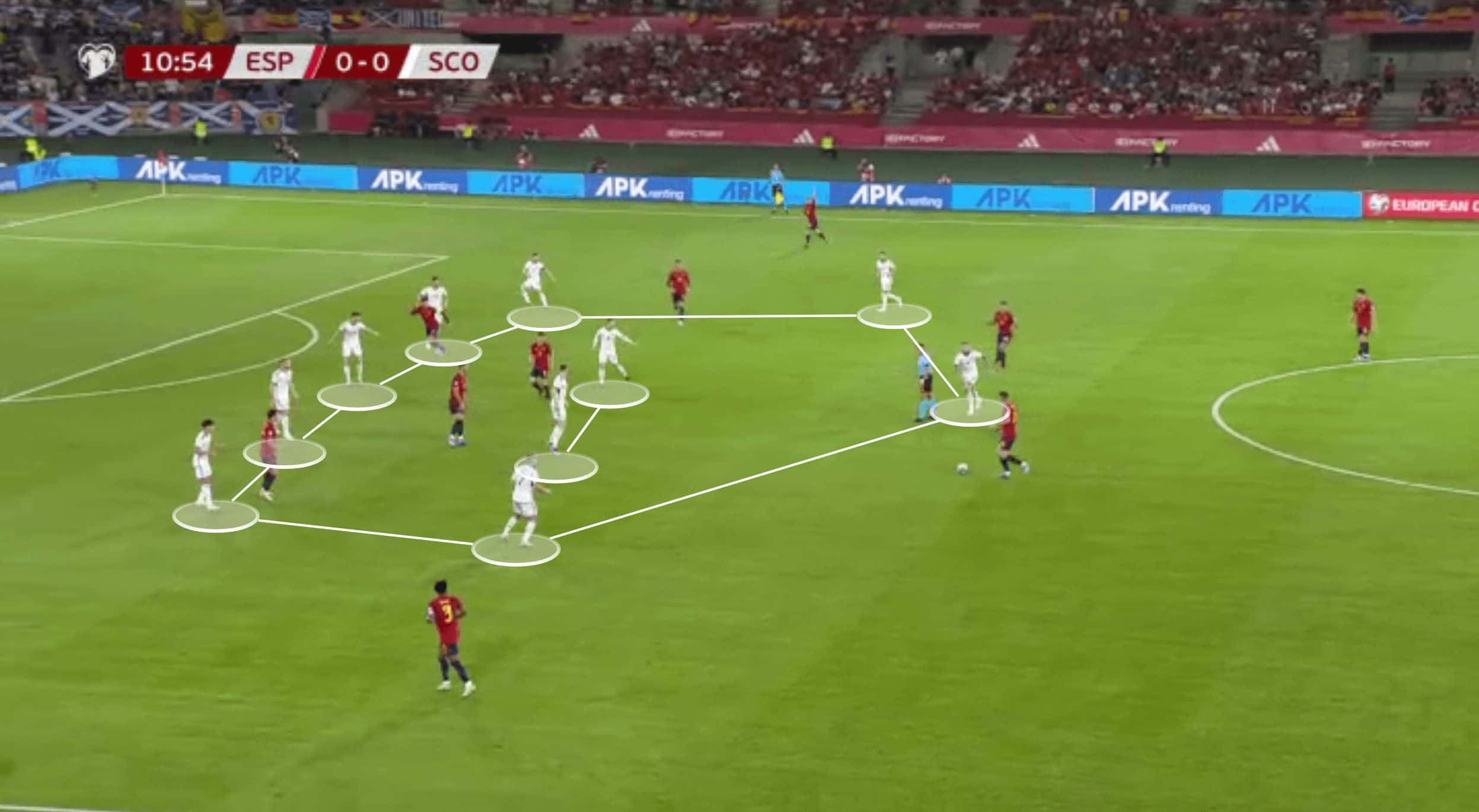
Scotland will typically take up deeper positions against the ball when they are in the defensive phase of the game.
They will crash back and defend in a tight block with a line of 5 at the back and then four across the midfield with one striker higher and able to apply pressure.
Defensively, Scotland is extremely effective at working to deny the opposition spaces between the lines in which they can attack.
This is why this summer, we fully expect Scotland to be deep and compact against all of their opponents.
The key for the Scottish defensive structure is for them to remain disciplined in sliding their line and structure from side to side to deny the opposition any chances to play into central areas.
When the fullbacks are forced to come outside to defend wide 1v1, we see one of the central midfielders slide across to cut off the central passing lanes as they try to regain possession in those tight spaces.
When Scotland do win the ball back in these areas, they will look for opportunities to quickly transition into the attack with direct passes into space behind the defensive line.
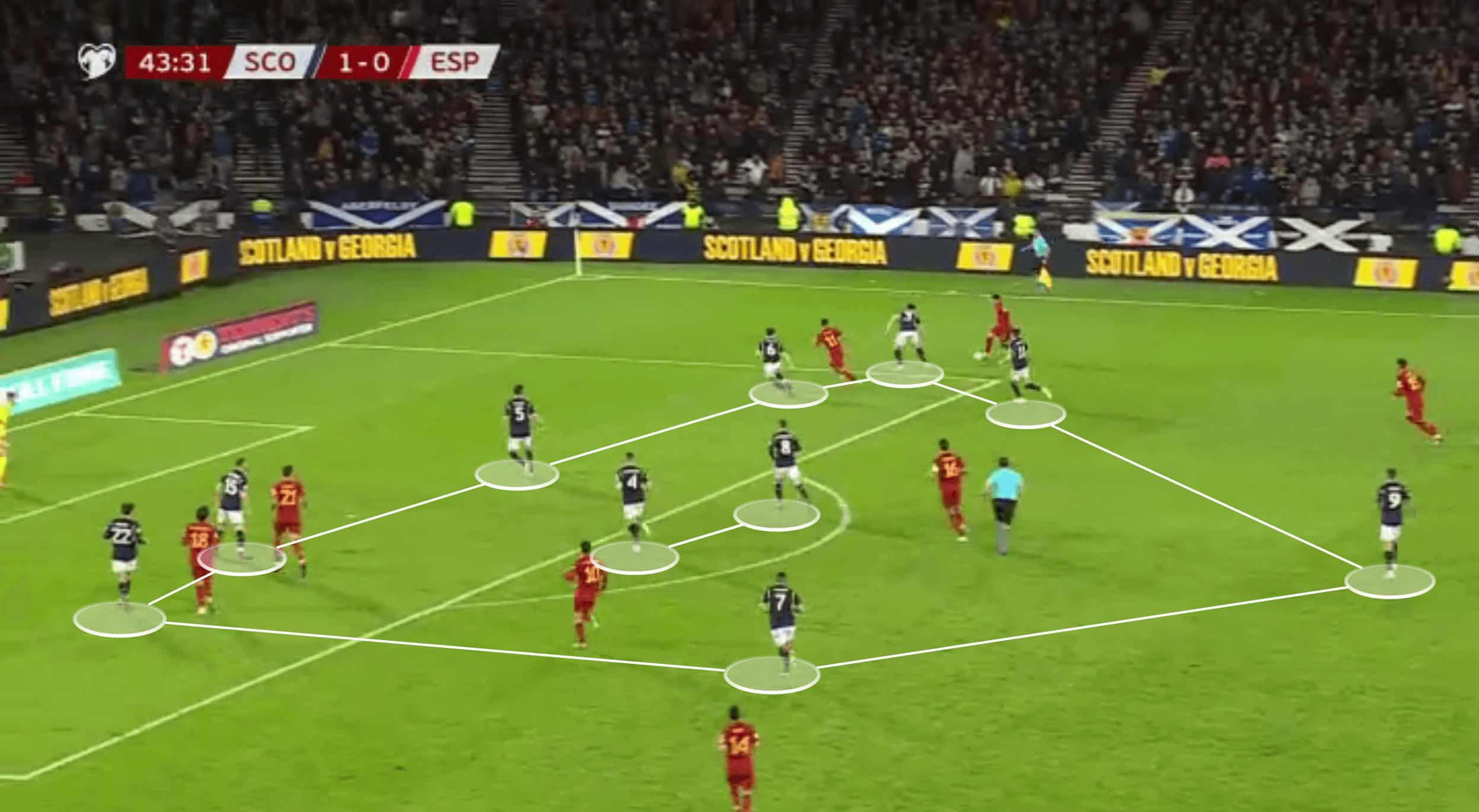
Here, we again see Scotland arranged in a deep and compact defensive block that effectively denies Spain space between the lines that they can play into.
As the ball is passed out to the wide areas, we see the left-back and left-sided midfielder for Scotland slide across to defend tight and look for an opportunity to regain the ball.
Scotland work extremely hard to maintain their spacing against the ball in these situations.
They will not typically press high or aggressively; instead, they will drop into their compact block quickly to cut out any space the opposition can play into.
This summer, we will see a similar approach from the Scottish side in their group stages, especially in the opener against Germany.
Transitions
When Scotland do get opportunities to launch attacking transitions from their deep and compact defensive block, they will typically look to attack at speed with a preference for moving central players quickly into attacking players.
They do not have great speed in their squad, but they do have some powerful runners who are comfortable when asked to make regular high-intensity runs into advanced areas and then back into their defensive shape.
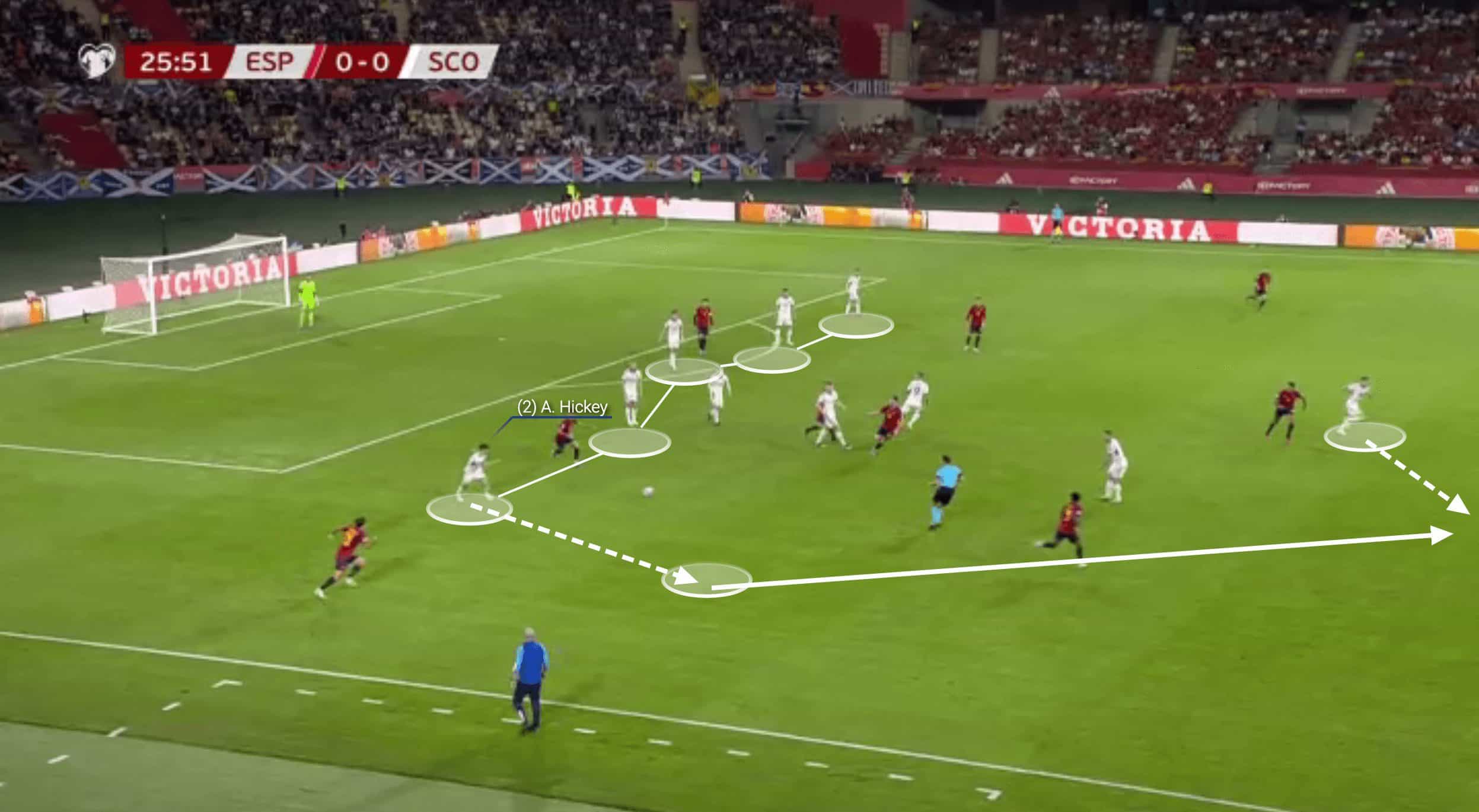
Here, we see an example of Scotland attacking in quick transitions to get beyond the Spanish block and into favourable attacking positions.
Scotland will be disciplined in terms of sitting back in their defensive block and cutting off any passing options.
We see this here as the Spanish eventually make a mistake with Aaron Hickey, as the Scottish right-back, picking up possession and driving wide to take the space that is available on his side of the pitch.
As soon as the opportunity to attack in transition presents itself, Scotland’s striker makes a high-intensity run to stretch the pitch and give the option for the quick forward pass.
Even against top opponents, as we see here against Spain, we will see Scotland create opportunities to attack in transition through their compact defending and quick attacking bursts forward.
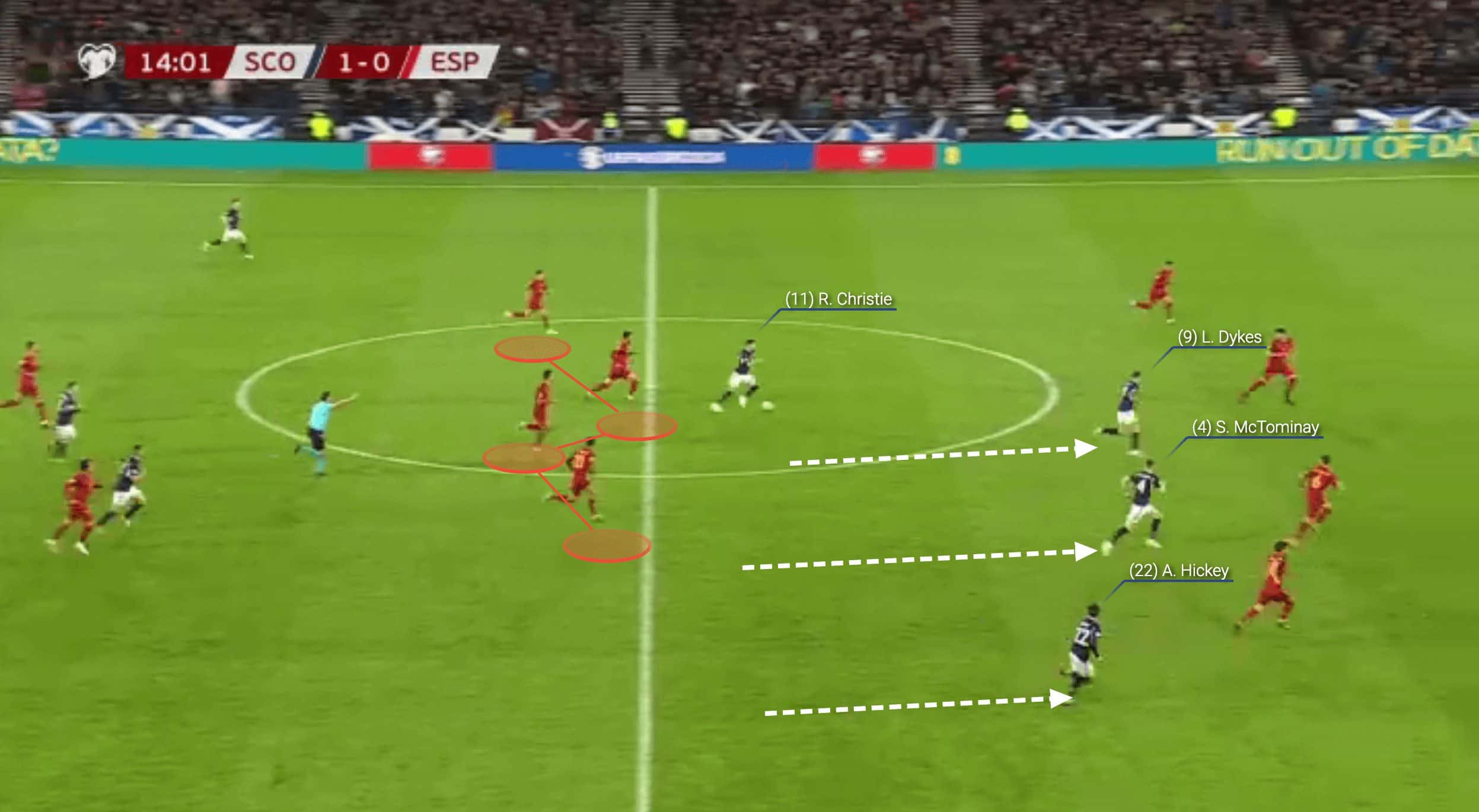
When Scotland get opportunities to attack in transition, they will commit players into advanced areas in order to quickly overload and overwhelm the opposition defence before they can get set into a settled structure.
Scotland do not necessarily have the quality to hold possession and dominate the game, although, in the likes of Billy Gilmour, they do have strong technical footballers.
By defending in a more deep and compact shape in the way that they will look to do, Scotland are effectively trying to force the opposition to press out as they look for ways to break down the Scottish defence.
This then allows Scotland to attack through quick transitions with players streaming forward.
We see this in this example, with Scotland quickly breaking out and through Spain’s defensive block.
As Ryan Christie gets on the ball behind Spain’s defensive line, three Scottish players make long runs to stretch the play and break through into the opposition’s final third.
Forwards
If Che Adams is fully fit in time for the tournament to start, then he will likely lead the line for Scotland.
The Southampton man is selfless in his approach to the attacking side of the game, and he will work selflessly to drag defenders out of shape and give Scotland an attacking platform.
Lyndon Dykes offers a different option as more of a target man type who excels in the air with the ability to play with real physicality.
The other striker option in the squad is the Hearts forward Lawrence Shankland, who is more of a poacher type.
Midfielders
Midfield is probably the strongest area for the Scottish national team, with John McGinn, Scott McTominay, Callum McGregor, and Ryan Christie all likely to start.
They also have depth in this position, with Billy Gilmour and Stuart Armstrong behind them and Ryan Jack and Kenny McLean as more deep backup options.
Defenders
Andy Robertson is nailed on to start as the left-back for Scotland in Germany, but the right-back is more up for grabs, as Ross McCrorie has been drafted as injury backup.
Kieran Tierney should play as the left-sided central defender, but Scott McKenna will provide competition for the role.
Jack Hendry and Ryan Porteous have done enough to cement their roles, with Grant Hanley and Liam Cooper as backups beyond that.
Key Player
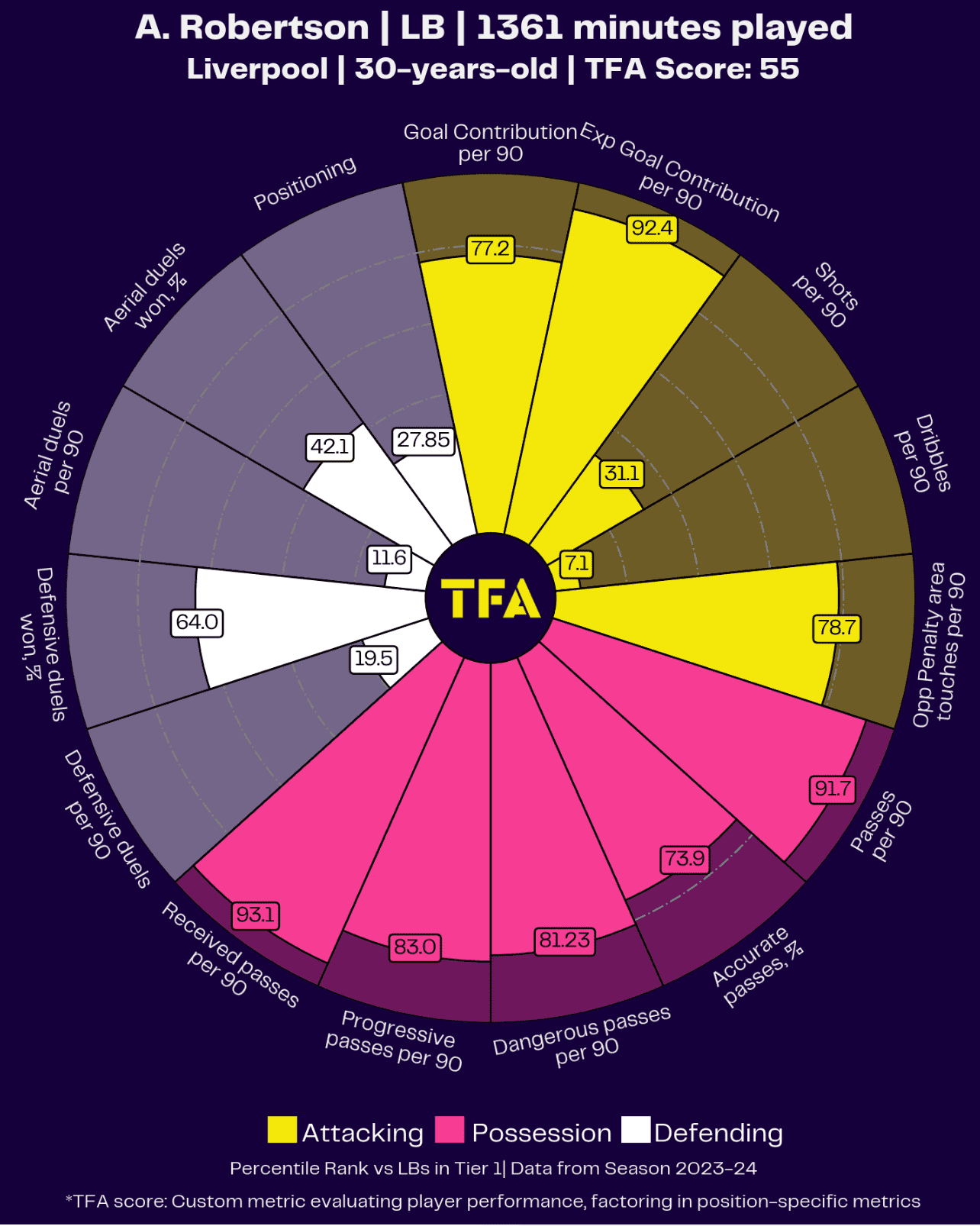
Choosing the key player for Scotland was actually tough.
John McGinn is consistently excellent for Scotland and is coming off a strong season with Aston Villa.
Andy Robertson, however, is still the most important player and captain of the national team.
Robertson is the perfect player to defend in a tight and compact block but also to understand how and when to break out and launch attacking transitions or to be the player offering width and depth from an attacking perspective.
His crossing ability and willingness to repeat high-intensity runs will also make Robertson one of Scotland’s key players in possession.
Tournament Prediction
Will this finally be the point that Scotland manage to qualify from the group stages and reach the knockouts of a major competition? They have a tricky, if not impossible, group with Germany, Hungary and Switzerland ahead of them.
A positive result in the opening game of the tournament against the hosts, Germany might well set up the Scottish to do something special.

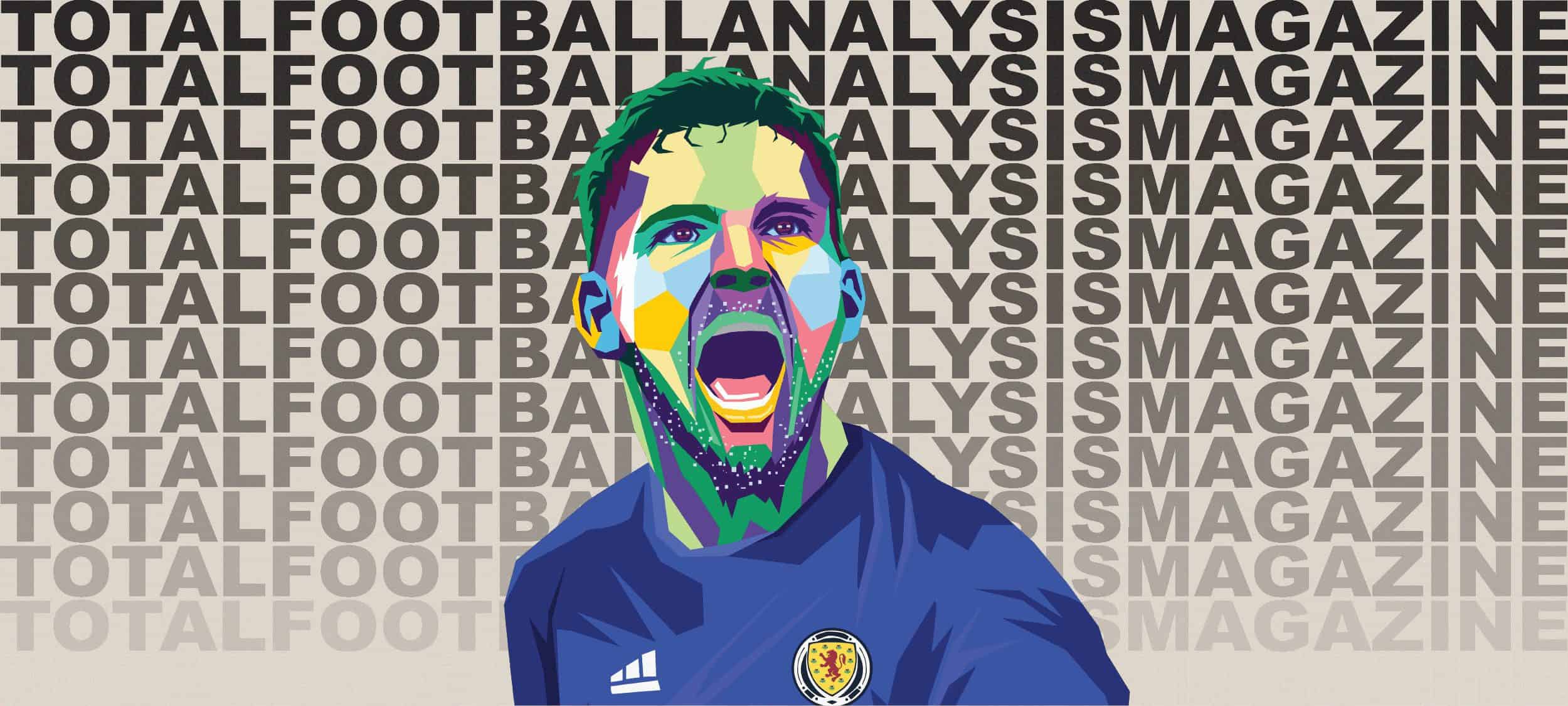




Comments